Yuxuan Ding
Bi-Residual Neural Network based Synchronous Motor Electrical Faults Diagnosis: Intra-link Layer Design for High-frequency Features
May 29, 2025



Abstract:In practical resource-constrained environments, efficiently extracting the potential high-frequency fault-critical information is an inherent problem. To overcome this problem, this work suggests leveraging a bi-residual neural network named Bi-ResNet to extract the inner spatial-temporal high-frequency features using embedded spatial-temporal convolution blocks and intra-link layers. It can be considered as embedding a high-frequency extractor into networks without adding any parameters, helping shallow networks achieve the performance of deep networks. In our experiments, five advanced CNN-based neural networks and two baselines across a real-life dataset are utilized for synchronous motor electrical fault diagnosis to demonstrate the effectiveness of Bi-ResNet including one analytical, comparative, and ablation experiments. The corresponding experiments show: 1) The Bi-ResNet can perform better on low-resolution noisy data. 2) The proposed intra-links can help high-frequency components extraction and location from raw data. 3) There is a trade-off between intra-link number and input data complexity.
TOMATO: Assessing Visual Temporal Reasoning Capabilities in Multimodal Foundation Models
Oct 30, 2024



Abstract:Existing benchmarks often highlight the remarkable performance achieved by state-of-the-art Multimodal Foundation Models (MFMs) in leveraging temporal context for video understanding. However, how well do the models truly perform visual temporal reasoning? Our study of existing benchmarks shows that this capability of MFMs is likely overestimated as many questions can be solved by using a single, few, or out-of-order frames. To systematically examine current visual temporal reasoning tasks, we propose three principles with corresponding metrics: (1) Multi-Frame Gain, (2) Frame Order Sensitivity, and (3) Frame Information Disparity. Following these principles, we introduce TOMATO, Temporal Reasoning Multimodal Evaluation, a novel benchmark crafted to rigorously assess MFMs' temporal reasoning capabilities in video understanding. TOMATO comprises 1,484 carefully curated, human-annotated questions spanning six tasks (i.e., action count, direction, rotation, shape & trend, velocity & frequency, and visual cues), applied to 1,417 videos, including 805 self-recorded and -generated videos, that encompass human-centric, real-world, and simulated scenarios. Our comprehensive evaluation reveals a human-model performance gap of 57.3% with the best-performing model. Moreover, our in-depth analysis uncovers more fundamental limitations beyond this gap in current MFMs. While they can accurately recognize events in isolated frames, they fail to interpret these frames as a continuous sequence. We believe TOMATO will serve as a crucial testbed for evaluating the next-generation MFMs and as a call to the community to develop AI systems capable of comprehending human world dynamics through the video modality.
EZIGen: Enhancing zero-shot subject-driven image generation with precise subject encoding and decoupled guidance
Sep 12, 2024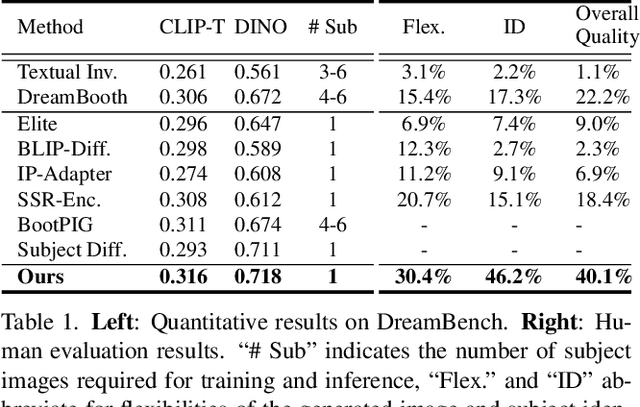
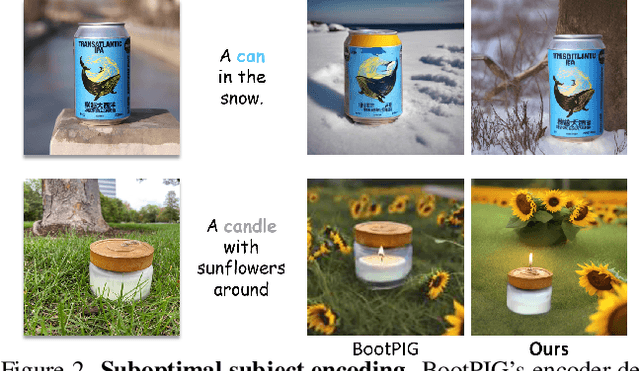
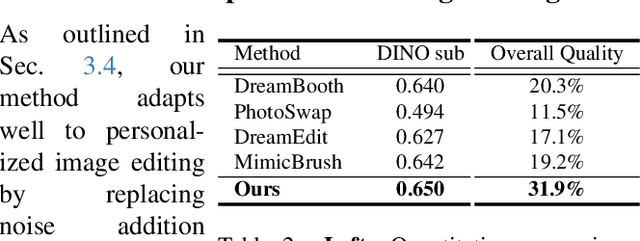
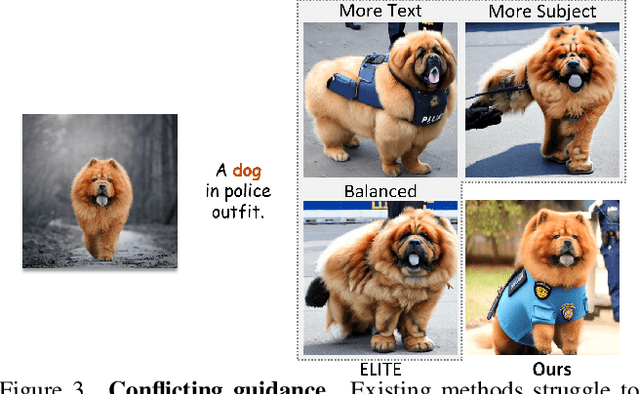
Abstract:Zero-shot subject-driven image generation aims to produce images that incorporate a subject from a given example image. The challenge lies in preserving the subject's identity while aligning with the text prompt, which often requires modifying certain aspects of the subject's appearance. Despite advancements in diffusion model based methods, existing approaches still struggle to balance identity preservation with text prompt alignment. In this study, we conducted an in-depth investigation into this issue and uncovered key insights for achieving effective identity preservation while maintaining a strong balance. Our key findings include: (1) the design of the subject image encoder significantly impacts identity preservation quality, and (2) generating an initial layout is crucial for both text alignment and identity preservation. Building on these insights, we introduce a new approach called EZIGen, which employs two main strategies: a carefully crafted subject image Encoder based on the UNet architecture of the pretrained Stable Diffusion model to ensure high-quality identity transfer, following a process that decouples the guidance stages and iteratively refines the initial image layout. Through these strategies, EZIGen achieves state-of-the-art results on multiple subject-driven benchmarks with a unified model and 100 times less training data.
The CLIP Model is Secretly an Image-to-Prompt Converter
May 22, 2023



Abstract:The Stable Diffusion model is a prominent text-to-image generation model that relies on a text prompt as its input, which is encoded using the Contrastive Language-Image Pre-Training (CLIP). However, text prompts have limitations when it comes to incorporating implicit information from reference images. Existing methods have attempted to address this limitation by employing expensive training procedures involving millions of training samples for image-to-image generation. In contrast, this paper demonstrates that the CLIP model, as utilized in Stable Diffusion, inherently possesses the ability to instantaneously convert images into text prompts. Such an image-to-prompt conversion can be achieved by utilizing a linear projection matrix that is calculated in a closed form. Moreover, the paper showcases that this capability can be further enhanced by either utilizing a small amount of similar-domain training data (approximately 100 images) or incorporating several online training steps (around 30 iterations) on the reference images. By leveraging these approaches, the proposed method offers a simple and flexible solution to bridge the gap between images and text prompts. This methodology can be applied to various tasks such as image variation and image editing, facilitating more effective and seamless interaction between images and textual prompts.
How Close is ChatGPT to Human Experts? Comparison Corpus, Evaluation, and Detection
Jan 18, 2023Abstract:The introduction of ChatGPT has garnered widespread attention in both academic and industrial communities. ChatGPT is able to respond effectively to a wide range of human questions, providing fluent and comprehensive answers that significantly surpass previous public chatbots in terms of security and usefulness. On one hand, people are curious about how ChatGPT is able to achieve such strength and how far it is from human experts. On the other hand, people are starting to worry about the potential negative impacts that large language models (LLMs) like ChatGPT could have on society, such as fake news, plagiarism, and social security issues. In this work, we collected tens of thousands of comparison responses from both human experts and ChatGPT, with questions ranging from open-domain, financial, medical, legal, and psychological areas. We call the collected dataset the Human ChatGPT Comparison Corpus (HC3). Based on the HC3 dataset, we study the characteristics of ChatGPT's responses, the differences and gaps from human experts, and future directions for LLMs. We conducted comprehensive human evaluations and linguistic analyses of ChatGPT-generated content compared with that of humans, where many interesting results are revealed. After that, we conduct extensive experiments on how to effectively detect whether a certain text is generated by ChatGPT or humans. We build three different detection systems, explore several key factors that influence their effectiveness, and evaluate them in different scenarios. The dataset, code, and models are all publicly available at https://github.com/Hello-SimpleAI/chatgpt-comparison-detection.
Position-Aware Relation Learning for RGB-Thermal Salient Object Detection
Sep 21, 2022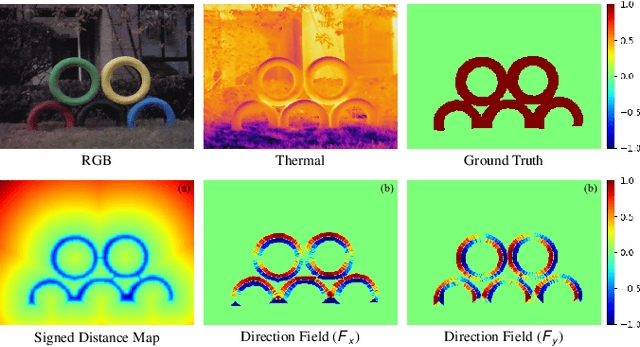
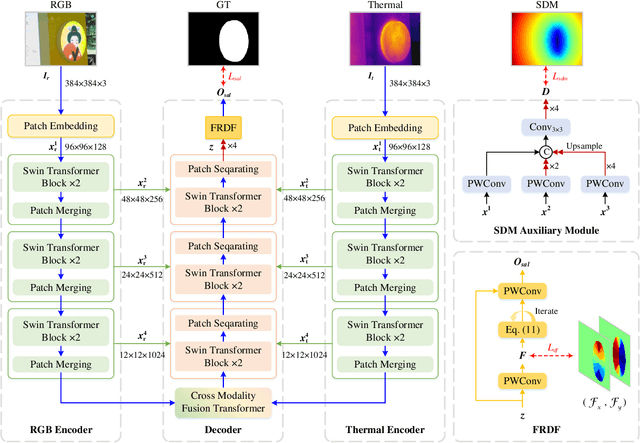


Abstract:RGB-Thermal salient object detection (SOD) combines two spectra to segment visually conspicuous regions in images. Most existing methods use boundary maps to learn the sharp boundary. These methods ignore the interactions between isolated boundary pixels and other confident pixels, leading to sub-optimal performance. To address this problem,we propose a position-aware relation learning network (PRLNet) for RGB-T SOD based on swin transformer. PRLNet explores the distance and direction relationships between pixels to strengthen intra-class compactness and inter-class separation, generating salient object masks with clear boundaries and homogeneous regions. Specifically, we develop a novel signed distance map auxiliary module (SDMAM) to improve encoder feature representation, which takes into account the distance relation of different pixels in boundary neighborhoods. Then, we design a feature refinement approach with directional field (FRDF), which rectifies features of boundary neighborhood by exploiting the features inside salient objects. FRDF utilizes the directional information between object pixels to effectively enhance the intra-class compactness of salient regions. In addition, we constitute a pure transformer encoder-decoder network to enhance multispectral feature representation for RGB-T SOD. Finally, we conduct quantitative and qualitative experiments on three public benchmark datasets.The results demonstrate that our proposed method outperforms the state-of-the-art methods.
Seeking Subjectivity in Visual Emotion Distribution Learning
Jul 25, 2022
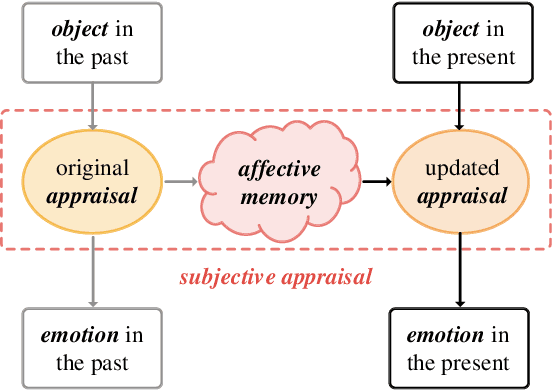


Abstract:Visual Emotion Analysis (VEA), which aims to predict people's emotions towards different visual stimuli, has become an attractive research topic recently. Rather than a single label classification task, it is more rational to regard VEA as a Label Distribution Learning (LDL) problem by voting from different individuals. Existing methods often predict visual emotion distribution in a unified network, neglecting the inherent subjectivity in its crowd voting process. In psychology, the \textit{Object-Appraisal-Emotion} model has demonstrated that each individual's emotion is affected by his/her subjective appraisal, which is further formed by the affective memory. Inspired by this, we propose a novel \textit{Subjectivity Appraise-and-Match Network (SAMNet)} to investigate the subjectivity in visual emotion distribution. To depict the diversity in crowd voting process, we first propose the \textit{Subjectivity Appraising} with multiple branches, where each branch simulates the emotion evocation process of a specific individual. Specifically, we construct the affective memory with an attention-based mechanism to preserve each individual's unique emotional experience. A subjectivity loss is further proposed to guarantee the divergence between different individuals. Moreover, we propose the \textit{Subjectivity Matching} with a matching loss, aiming at assigning unordered emotion labels to ordered individual predictions in a one-to-one correspondence with the Hungarian algorithm. Extensive experiments and comparisons are conducted on public visual emotion distribution datasets, and the results demonstrate that the proposed SAMNet consistently outperforms the state-of-the-art methods. Ablation study verifies the effectiveness of our method and visualization proves its interpretability.
Don't Stop Learning: Towards Continual Learning for the CLIP Model
Jul 20, 2022
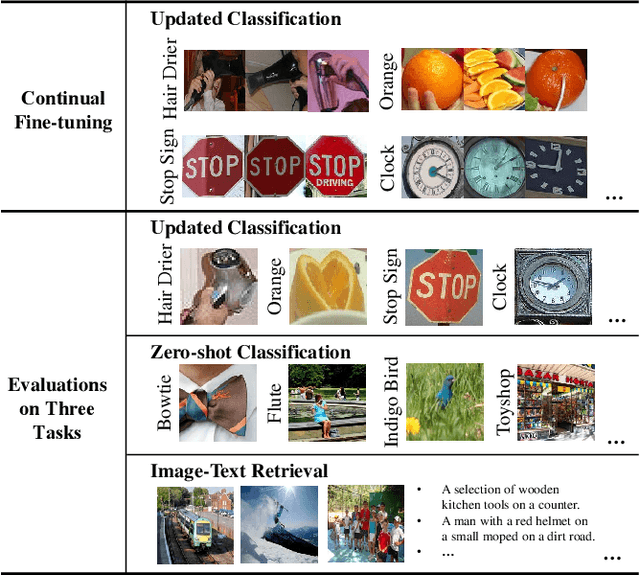
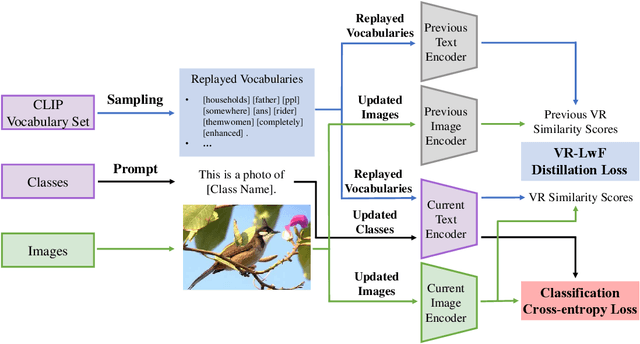
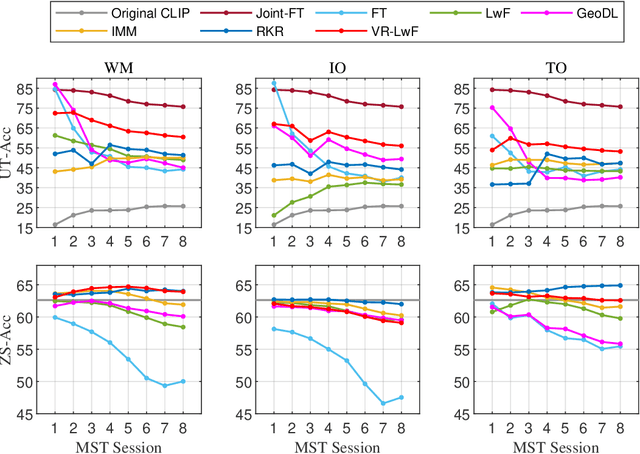
Abstract:The Contrastive Language-Image Pre-training (CLIP) Model is a recently proposed large-scale pre-train model which attracts increasing attention in the computer vision community. Benefiting from its gigantic image-text training set, the CLIP model has learned outstanding capabilities in zero-shot learning and image-text matching. To boost the recognition performance of CLIP on some target visual concepts, it is often desirable to further update the CLIP model by fine-tuning some classes-of-interest on extra training data. This operation, however, raises an important concern: will the update hurt the zero-shot learning or image-text matching capability of the CLIP, i.e., the catastrophic forgetting issue? If yes, could existing continual learning algorithms be adapted to alleviate the risk of catastrophic forgetting? To answer these questions, this work conducts a systemic study on the continual learning issue of the CLIP model. We construct evaluation protocols to measure the impact of fine-tuning updates and explore different ways to upgrade existing continual learning methods to mitigate the forgetting issue of the CLIP model. Our study reveals the particular challenges of CLIP continual learning problem and lays a foundation for further researches. Moreover, we propose a new algorithm, dubbed Learning without Forgetting via Replayed Vocabulary (VR-LwF), which shows exact effectiveness for alleviating the forgetting issue of the CLIP model.
Stimuli-Aware Visual Emotion Analysis
Sep 04, 2021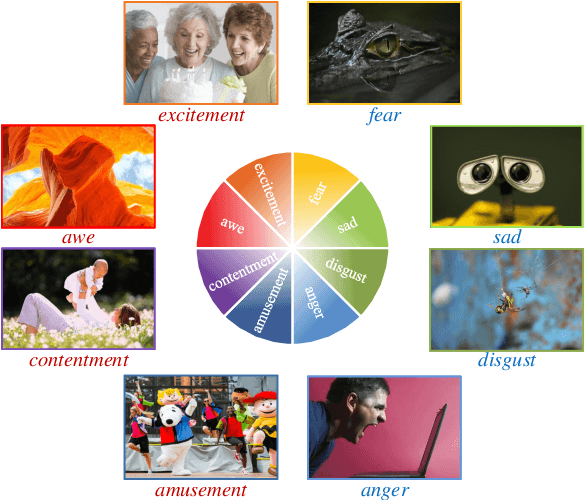
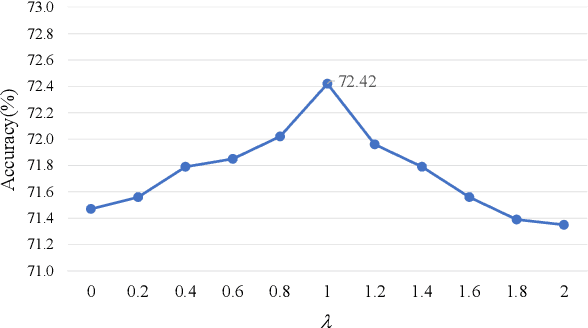
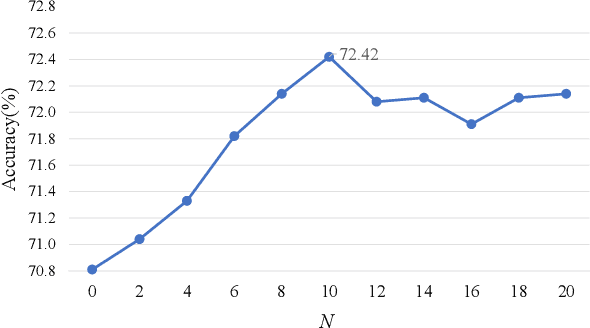

Abstract:Visual emotion analysis (VEA) has attracted great attention recently, due to the increasing tendency of expressing and understanding emotions through images on social networks. Different from traditional vision tasks, VEA is inherently more challenging since it involves a much higher level of complexity and ambiguity in human cognitive process. Most of the existing methods adopt deep learning techniques to extract general features from the whole image, disregarding the specific features evoked by various emotional stimuli. Inspired by the \textit{Stimuli-Organism-Response (S-O-R)} emotion model in psychological theory, we proposed a stimuli-aware VEA method consisting of three stages, namely stimuli selection (S), feature extraction (O) and emotion prediction (R). First, specific emotional stimuli (i.e., color, object, face) are selected from images by employing the off-the-shelf tools. To the best of our knowledge, it is the first time to introduce stimuli selection process into VEA in an end-to-end network. Then, we design three specific networks, i.e., Global-Net, Semantic-Net and Expression-Net, to extract distinct emotional features from different stimuli simultaneously. Finally, benefiting from the inherent structure of Mikel's wheel, we design a novel hierarchical cross-entropy loss to distinguish hard false examples from easy ones in an emotion-specific manner. Experiments demonstrate that the proposed method consistently outperforms the state-of-the-art approaches on four public visual emotion datasets. Ablation study and visualizations further prove the validity and interpretability of our method.
* Accepted by TIP
 Add to Chrome
Add to Chrome Add to Firefox
Add to Firefox Add to Edge
Add to Edge